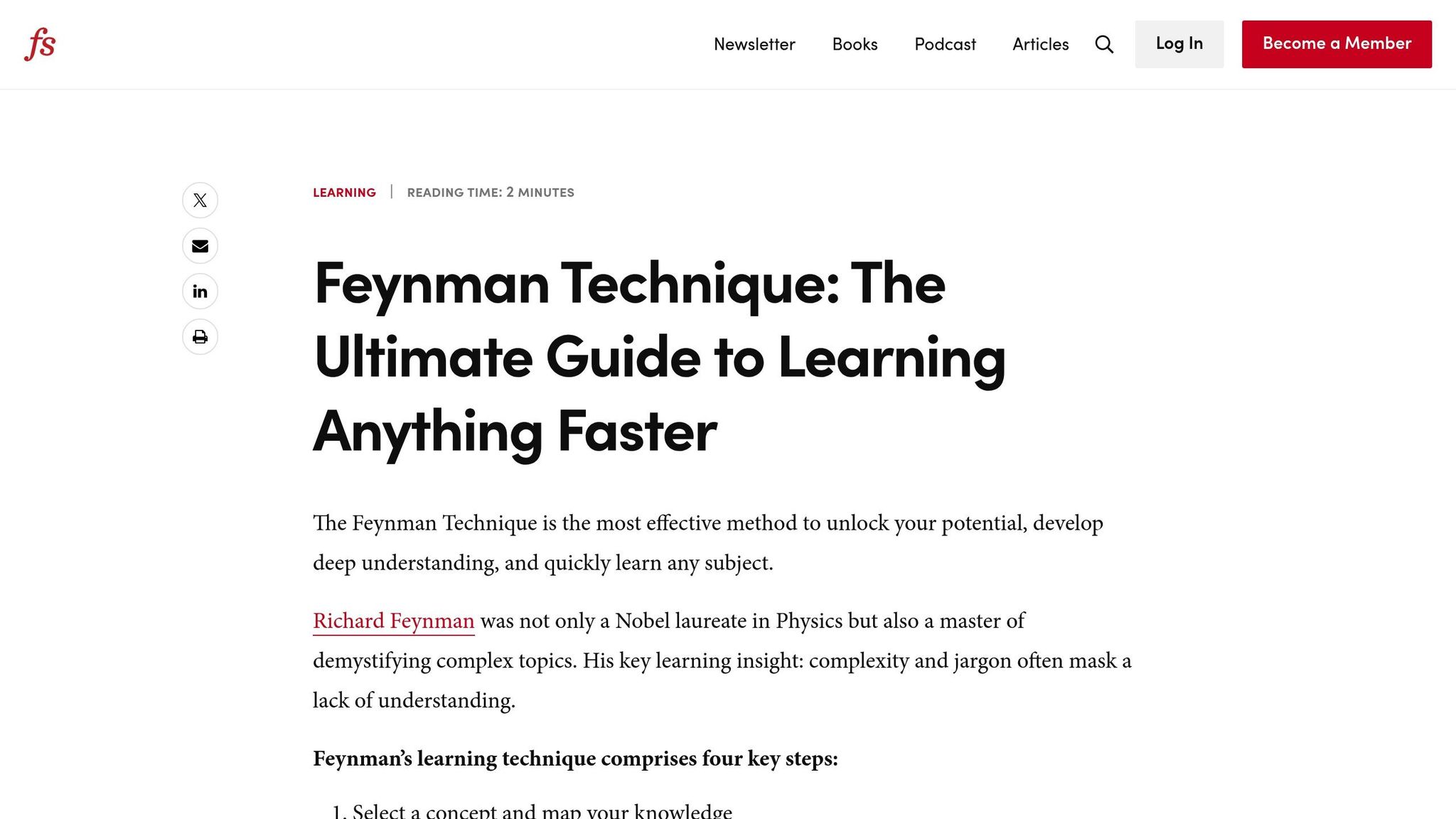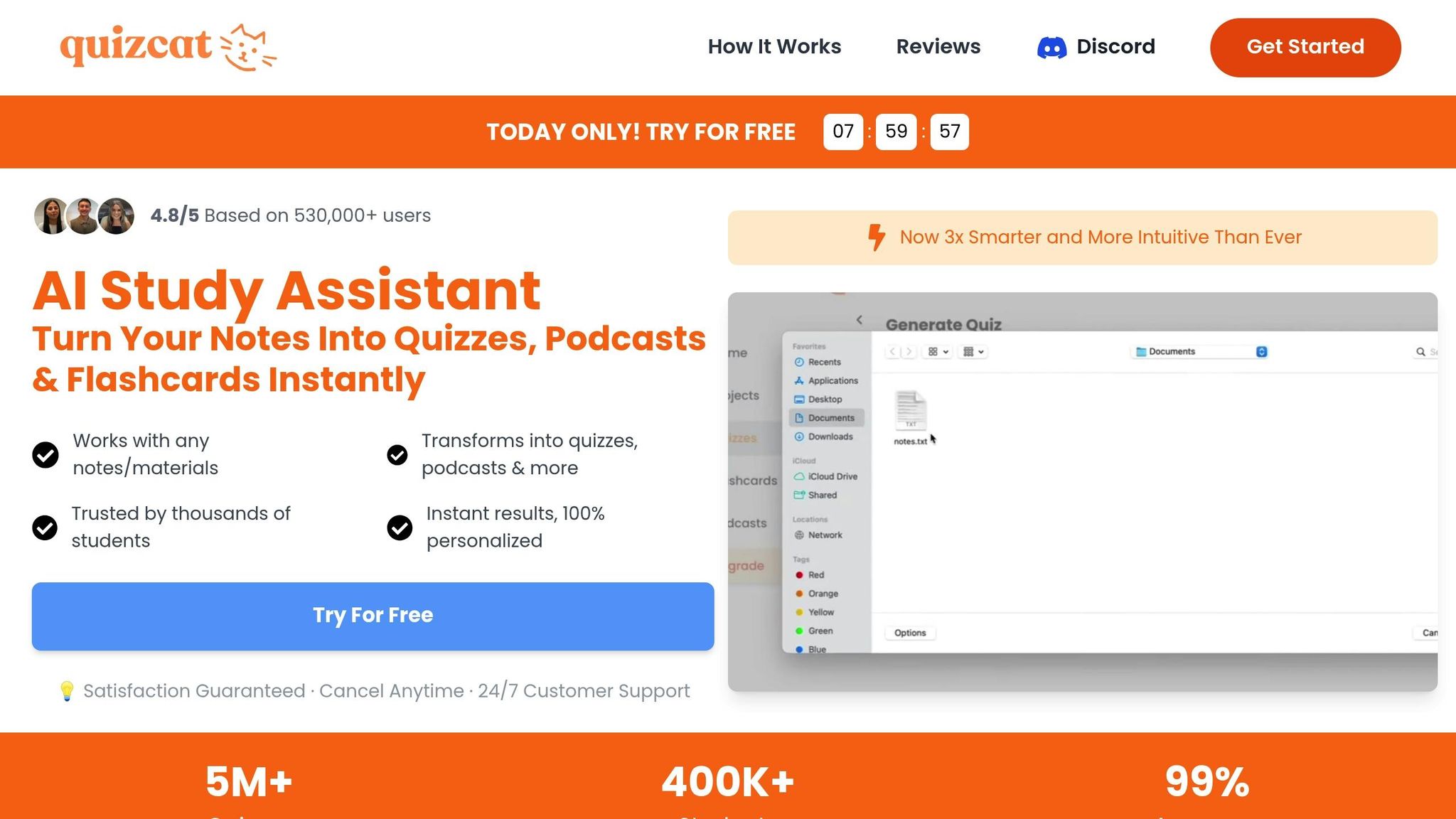
Active Recall Techniques Without Flashcards
Active recall is a powerful way to improve memory and learning by actively retrieving information instead of passively reviewing it. While flashcards are a common tool, they aren't always the best fit for every subject or learning style. Here's a quick overview of alternative techniques:
- Free Writing: Write everything you remember about a topic from memory, then review and refine.
- Self-Testing: Create your own questions to test understanding, focusing on key ideas and using varied formats.
- Teaching (Feynman Method): Explain concepts in simple terms as if teaching a middle schooler, identifying gaps in understanding.
- Summaries & Topic Reviews: Condense material into short summaries or list everything you know about a topic, then check for gaps.
- Concept Maps: Visualize complex relationships between ideas for better understanding.
These methods work well for subjects involving complex relationships, step-by-step processes, or creative thinking. Tools like QuizCat AI can assist by generating personalized quizzes and study materials from your notes, making active recall even more effective.
Use these techniques consistently and strategically (e.g., spaced repetition) to strengthen your memory and understanding.
12 ways to Active Recall in 12 minutes
Self-Testing Methods
Creating your own test questions is a smart way to reinforce what you've learned. It pushes you to engage with the material on a deeper level and spot areas that might need more attention.
Writing Effective Test Questions
The goal is to create questions that test your understanding, not just your ability to recall basic facts. Start by reviewing your study materials to find the most important ideas, then turn these into questions that require explanation or analysis.
Here are some tips for crafting strong test questions:
- Focus on Key Ideas: Go through your notes and highlight important concepts, definitions, and connections.
- Use Different Formats: Include a mix of question styles like "Why does this happen?", "How do these compare?", or "Can you give an example?"
- Provide Context: Add details to your questions that tie ideas to practical or real-life scenarios.
For extra help, tools like QuizCat AI can analyze your notes and create tailored questions that approach the material from various angles.
Once you’ve made your questions, the next step is to schedule your reviews strategically.
Scheduling Your Self-Tests
Timing matters when it comes to self-testing. Here's a suggested schedule:
1. First Test
Review your questions within 24 hours of learning the material. This helps solidify your memory and quickly highlights areas where you might be struggling.
2. Follow-Up Tests
Plan follow-up tests at gradually increasing intervals:
- 3 days after the initial review
- 1 week later
- 2 weeks later
- 1 month later
3. Adjust as Needed
Track how you're doing on these tests. If you're scoring well, you can space out your review sessions more. If you're finding certain topics tough, shorten the intervals to revisit them sooner.
AI tools like QuizCat AI can simplify this process by automatically generating fresh questions for each review session. This keeps your focus on truly understanding the material instead of just memorizing specific answers.
Free Writing from Memory
Free writing from memory is an active recall method that helps identify what you know and where you're struggling. It’s a great way to reinforce learning while sharpening your ability to recall and analyze information. Here’s how you can make the most of this technique.
Steps for Free Writing
1. Get Ready
Grab a blank sheet of paper or open a new document. Put away all study materials. Pick a specific topic or concept to focus on.
2. Start Writing
Write down everything you can remember about the topic. Don’t worry about structure - just keep writing until your timer runs out.
3. Organize Your Thoughts
Take five minutes to review what you’ve written. Group related ideas together and highlight areas where you feel confident, uncertain, or completely blank.
4. Check Your Work
Compare your notes to your study materials to see what you missed or got wrong. Tools like QuizCat AI can also help identify weak points and guide your next steps.
Why Free Writing Helps
Free writing isn’t just about testing yourself - it’s an active learning process that strengthens understanding. Here’s why it works so well:
Instant Insights
Writing freely about a topic quickly shows what you know and what you don’t. This immediate feedback lets you focus your time on areas that need improvement.
Deeper Thinking
Unlike simple recognition tasks, free writing pushes you to:
- Connect different ideas
- Explain how concepts relate
- Build clear, logical explanations
Better Memory
The act of recalling and organizing information strengthens your brain’s pathways, making it easier to remember later. Research shows this effort improves long-term retention.
Spotting Patterns
You’ll start to notice patterns in how you learn and retain information. This awareness can help you tweak your study habits for better results.
To get the most out of free writing:
- Practice 2–3 times a week
- Cover a variety of topics
- Gradually tackle more complex material
- Track your progress over time
For extra help, use QuizCat AI to analyze your writing and get targeted feedback.
sbb-itb-1e479da
Teaching as Learning: The Feynman Method

The Feynman Method, inspired by Nobel Prize-winning physicist Richard Feynman, uses teaching as a way to strengthen your understanding of any topic. This approach turns teaching into an active recall exercise, helping you pinpoint and address gaps in your knowledge.
How to Use the Feynman Method
Teaching others goes beyond traditional study methods like self-quizzing or free writing. The Feynman Method challenges you to explain complex ideas in simple, straightforward terms.
Steps to Follow:
- Pick a concept you want to learn deeply.
- Pretend you're teaching it to a middle school student - stick to basic words and avoid technical jargon.
- Break the idea into smaller, easy-to-digest parts and use relatable examples or analogies.
- Review your explanation to identify unclear areas or where you're still relying on complex terms.
- Revise and simplify until you can explain the concept smoothly using everyday language.
Once you're confident, look for opportunities to share your explanation with others.
Finding Practice Students
There are many ways to put the Feynman Method into action, whether with real people or creative alternatives.
Real People
- Join a study group.
- Teach a classmate or family member.
- Participate in online forums or communities.
Creative Alternatives
- Record a video of yourself explaining the topic.
- Write a tutorial or blog post.
- Use voice memos to practice speaking the explanation.
- Try the "rubber duck" method - explain the concept to an object like a rubber duck.
- Draw concept maps while talking through the topic.
Don't worry if you stumble during the process - that's part of learning. Each attempt helps you refine your understanding and shows you what needs more work.
Other Memory Testing Methods
There are other ways to strengthen memory and identify knowledge gaps beyond using flashcards. These methods can help you actively recall information and deepen your understanding.
Quick Summary Writing
Writing summaries helps you focus on the main ideas and test your understanding by condensing information into a few sentences.
How to Write Effective Summaries:
- Start with a blank page, set a 2-minute timer, and jot down the key concepts and details.
- Write everything you can remember about the topic.
- Use your own words instead of copying definitions.
- Compare your summary to the original material to identify what you missed.
This technique pushes you to simplify complex information into its most important points, making it clear what you truly understand. It’s a great way to quickly reinforce your learning.
Quick Topic Reviews
Quick topic reviews go a step further by encouraging you to list everything you know about a subject. This approach helps you see both what you’ve mastered and what needs more attention.
Steps for an Effective Topic Review:
- Pick a specific topic or concept.
- Set a 5-minute timer.
- Write nonstop without looking at your notes.
- Include examples, connections, and real-world applications.
- Review your notes afterward to find any gaps.
The main difference between summaries and topic reviews is the level of detail. Summaries focus on the essentials, while topic reviews allow for a deeper dive. For instance, a summary on cell biology might explain what mitochondria are and their function, while a topic review could include their structure, processes, related diseases, and connections to other cellular parts.
Both of these methods work best when done consistently, especially at the end of a study session. They’re simple but effective ways to boost retention and understanding.
Using QuizCat AI for Active Recall

Digital tools can take your active recall practice to the next level. QuizCat AI offers tools designed to strengthen your memory, going beyond traditional flashcards. These tools integrate smoothly with the active recall techniques mentioned earlier.
QuizCat AI Features
QuizCat AI turns your study materials into interactive learning tools. You can upload notes in formats like PDF, DOCX, and TXT, and the platform automatically generates:
- Interactive Quizzes to test your understanding
- Study Podcasts that turn your notes into audio lessons
- Smart Learning Paths that adjust your study plan based on your performance
With an impressive 99% accuracy in content analysis, QuizCat AI ensures you stay actively engaged with your learning materials.
Why Use QuizCat AI
Over 400,000 students trust QuizCat AI, which has created more than 5 million quizzes and earned a 4.8/5 rating.
Here’s why it stands out:
- Personalized Learning: The platform adapts to your pace and highlights areas where you need more practice, helping you make the most of your study time.
-
Multiple Formats: Switch effortlessly between quizzes, flashcards, and audio lessons. As Maya Johnson puts it:
"Uploading my notes and instantly having quizzes ready feels like magic. This tool has completely changed the way I study. I actually feel prepared for once!"
-
Convenience on the Go: With mobile and tablet compatibility, you can practice active recall anywhere. Emily Carter shares:
"I was drowning in notes before I found this tool. Now, it turns everything into flashcards, quizzes, and even podcasts!"
These features align perfectly with active recall methods, offering immediate feedback and a variety of ways to engage with your materials. This consistent interaction helps solidify what you’ve learned.
Summary
Active recall is most effective when used in different ways, not just with flashcards. Techniques like self-testing, free writing, and teaching help simplify tough topics and point out areas where more focus is needed. The Feynman Method is especially useful for breaking down complex ideas into simple explanations, showing exactly where your understanding needs work.
You can take these methods further with digital tools that support active recall. For example, QuizCat AI turns your notes into interactive, accurate study materials with a 99% success rate in content analysis. Students like Sophia Martinez have seen impressive results:
"I was skeptical at first, but wow. The quizzes it makes from my notes are so spot-on. My test scores have gone up, and I actually enjoy studying now. Who even am I? 😅"
With more than 400,000 students and 5 million quizzes created, QuizCat AI has become a go-to tool for busy learners. As Noah Perez shares:
"The quizzes are great, but the real MVP is the podcast feature. It's perfect for cramming while I'm doing other stuff. 10/10 would recommend."
